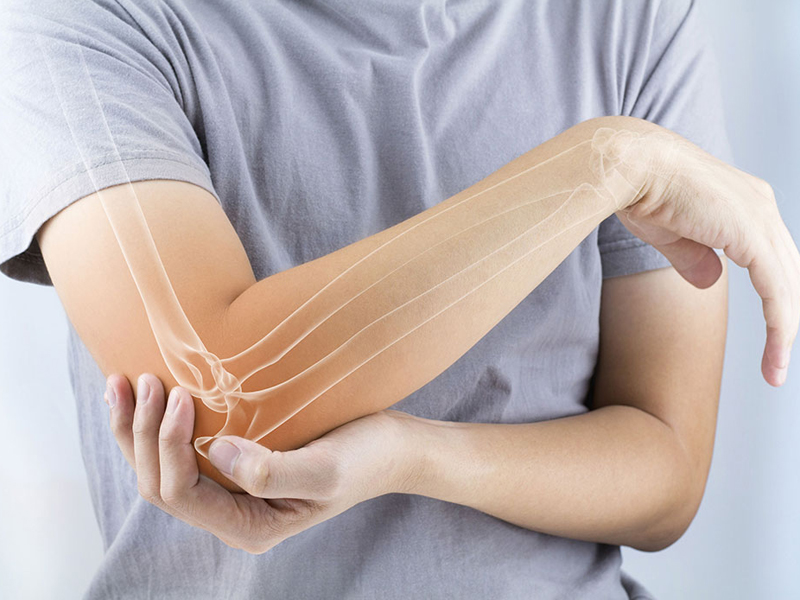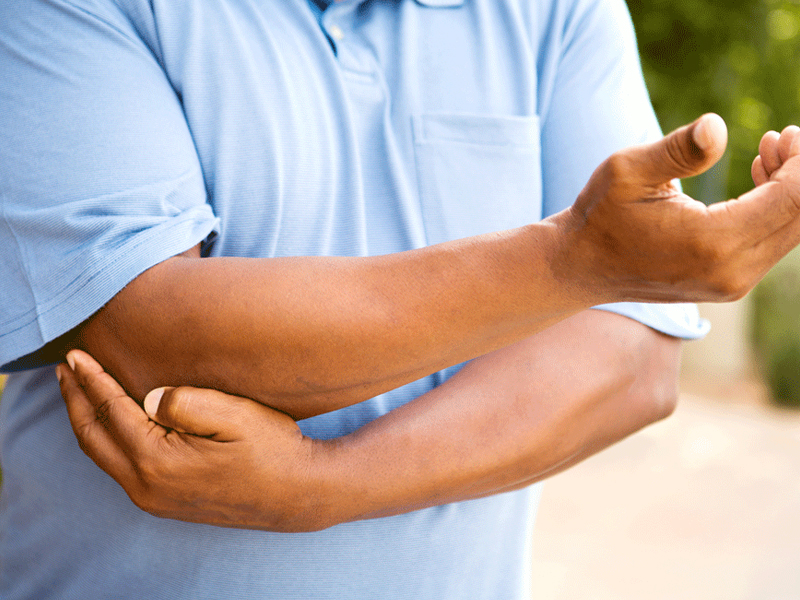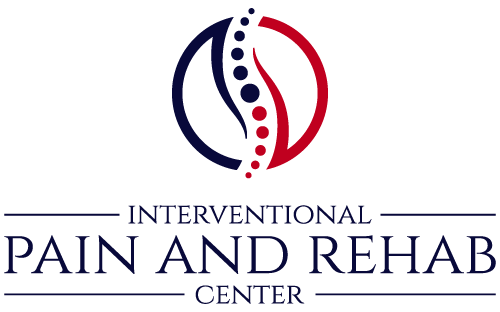Elbow Pain
Appointment
Fill Out The Form Below
Working Hour
- 8 AM - 5 PM
- 8 AM - 5 PM
- 8 AM - 5 PM
- 8 AM - 5 PM
- 8 AM - 5 PM
- Closed
- Closed

Elbow Pain
The joint that joins the middle three bones of your arm is called your elbow:
- (Upper arm bone) Humerus
- The inner forearm bone, or ulna
- (Outer forearm bone) Radius
It operates like a hinge, allowing your arm to move forward and backward. Your elbow can also twist inward and outward, which rotates your arm. Numerous other structures close to the elbow are needed to support this complex movement:
- Tendons connect the muscles above and below the elbow, enabling the joint to flex, extend, and rotate the arm.
- Sturdy connective tissue gives the joint flexibility and stability.
- A bursa, a little fluid sac near the end of the elbow, acts as a cushion and guards against injury or agitation to the ligaments, tendons, and joint.
- The area’s blood vessels guarantee that there is always enough blood available for movement.
- Nerves transmit signals that enable the movement you want to happen.
There are numerous ways in which an injury might happen since your elbow’s intricate structures interact to guarantee optimal function. Elbow pain may arise if any of these structures are damaged or wear down.
Typical Reasons for Elbow Pain
Elbow pain can have a variety of reasons. In order to guarantee that you receive the best possible therapy for your ailment, a correct diagnosis is essential.
One-Time Accidents
There’s a chance that the damage you’re experiencing is related to a single incident. Among them are:
- One of your arm bones may break at the joint if you take a hard hit to the elbow. This most frequently happens in catastrophic falls, car accidents, and sports injuries.
- When one of the bones that support this joint is knocked out of alignment, the elbow becomes dislocated. This is a typical injury that occurs when you extend your hand to support yourself after you fall.
- A sprain happens when ligaments are strained or damaged. A strain is brought on by strained or stretched muscles. These injuries happen when your muscles and ligaments are overworked, which happens frequently when lifting large objects or engaging in physical activity.
Wear and Tear Damage
Your elbow may experience severe wear and tear from repetitive actions. These can be quite painful injuries that frequently result from sports or work conditions. Typical instances of injuries caused by repetitive movements include:
- Repetitive movements can cause the bursa that cushions your elbow to fill with fluid and swell, which can cause redness and discomfort. Trauma related to a fall may potentially cause harm to it.
- Overuse of your elbow might cause injury to its tendons. One kind of tendonitis that appears on the outside of the elbow is called “tennis elbow.” “Golfer’s elbow” is a type of tendonitis affecting the inside of the joint.
Additionally, injuries related to pronation and supination (elbow rotation) may arise with repeated use.
Nerve Damage
Nerve damage to the elbow is common. Common types of nerve injuries include:
- Ulnar nerve injury is the cause of cubital tunnel syndrome. It frequently causes burning or numbness down the inner arm that travels to the hand and fingers. In extreme circumstances, hand weakness could occur.
- The symptoms of radial tunnel syndrome include burning and numbness along the outside of the elbow and forearm, which is linked to injury to the radial nerve.

Arthritic
Elbow joint inflammation can lead to arthritis, which progressively worsens pain and stiffness. The following are the most prevalent forms of elbow arthritis:
- Rheumatoid arthritis: This is characterized by inflammation and pain in your elbow joint as a result of an immune system attack.
- Osteoarthritis: This condition occurs when your elbow’s cartilage degrades and the bones start to rub against one another. Elbow stiffness and discomfort are symptoms of osteoarthritis.
Blood Clots and Infections
Although less frequent, an infection in the joint or surrounding tissue may cause elbow pain. Elbow pain can also be caused by blood clots in the arm. Fever and edema may also be symptoms of these illnesses.
How to Treat Elbow Pain
Whenever feasible, we at the Denver Spine and Pain Institute advise conservative therapy. Treatment options for elbow discomfort vary and may include the following:
- Physical therapy aims to increase range of motion, reduce pain, and treat any underlying musculoskeletal issues that may be causing your elbow pain.
- Short-term symptom relief can be achieved with anti-inflammatory drugs and muscle relaxants, which will facilitate your participation in physical therapy.
- If medicine and physical therapy alone aren’t enough to relieve your symptoms, injections could be able to provide you the long-term respite you need. Using imaging guidance, our doctors will try to determine the most likely source of discomfort and inject medication into that location. Local anesthetic and steroid injections into the elbow joint and tendon are the most popular injection procedures.
- Platelet rich plasma (PRP) and stem cell therapies are examples of regenerative medicine therapy.
- Tenex is used to administer percutaneous needle fasciotomy, a therapy that is frequently successful in treating tendonitis.
Surgery can be required if these conservative measures are insufficient to relieve the patient’s symptoms. Before your surgical consultation, our staff will conduct all necessary diagnostic testing to pinpoint the exact source and location of your discomfort. Your surgeon will be able to arrange your procedure with the help of these diagnostic tests.
Regaining a Life Free of Pain
Persistent elbow pain can seriously lower your quality of life by making it difficult to carry out your favorite activities and regular daily duties. Thankfully, this agony is no longer something you have to endure. We provide the most cutting-edge therapies at the Denver Spine and discomfort Institute to relieve your elbow discomfort and get you back to enjoying life.
- A comprehensive range of services, including doctors, physical therapy, massage, counseling on diet and lifestyle, behavioral health, research, and state-of-the-art treatment alternatives
- Forming healing and caring connections that cater to your individual needs
- Talking through your options and giving you the direction you require from a committed healthcare partner
- Assembling a knowledgeable group to manage your care program
